| Japanese honeysuckle | USDA PLANTS Symbol: LOJA U.S. Nativity: Exotic Habit: Vines |
| Lonicera japonica Thunb. |
Jump to: Resources | Images | Distribution Maps | Sources
|
Taxonomic Rank: Magnoliopsida: Dipsacales: Caprifoliaceae |
|
| Synonym(s): Chinese honeysuckle | |
| Native Range: E. Asia (REHD, BAIL); | |
Japanese honeysuckle is an evergreen to semi-evergreen vine that can be found either trailing or climbing to over 80 ft. (24 m) in length. Leaves are opposite, sessile, pubescent, oval and 1 to 2.5 in. (2.5-6.4 cm) long. Flowering occurs from April to July, when showy, fragrant, tubular, whitish-pink to yellow flowers develop in the axils of the leaves. Fruits develop in the fall and are small, shiny black berries. Japanese honeysuckle invades a variety of habitats including forest floors, canopies, roadsides, wetlands, and disturbed areas. Japanese honeysuckle can girdle small saplings by twining around them, and it can form dense mats in the canopies of trees, shading everything below. A native of eastern Asia, it was first introduced into North America in 1806 in Long Island, NY. Japanese honeysuckle has been planted widely throughout the United States as an ornamental, for erosion control, and for wildlife habitat. |
|
Identification, Biology, Control and Management Resources
|
| Selected Images from Invasive.org | View All Images at Invasive.org |
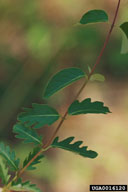 Foliage; Spring foliage with wavy margins Ted Bodner, Southern Weed Science Society, Bugwood.org Additional Resolutions & Image Usage |
 Foliage; Top and bottom (silvery) in May James H. Miller, USDA Forest Service, Bugwood.org Additional Resolutions & Image Usage |
 Foliage; Flowers and foliage Chuck Bargeron, University of Georgia, Bugwood.org Additional Resolutions & Image Usage |
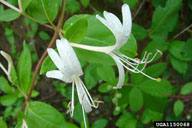 Flower(s); Chuck Bargeron, University of Georgia, Bugwood.org Additional Resolutions & Image Usage |
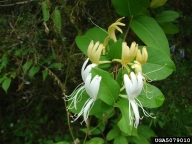 Flower(s); Troy Evans, Great Smoky Mountains National Park, Bugwood.org Additional Resolutions & Image Usage |
 Flower(s); Chuck Bargeron, University of Georgia, Bugwood.org Additional Resolutions & Image Usage |
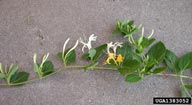 Plant(s); Tom Heutte, USDA Forest Service, Bugwood.org Additional Resolutions & Image Usage |
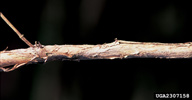 Twig(s)/Shoot(s); September James H. Miller, USDA Forest Service, Bugwood.org Additional Resolutions & Image Usage |
 Fruit(s); Immature fruit Chuck Bargeron, University of Georgia, Bugwood.org Additional Resolutions & Image Usage |
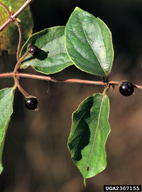 Fruit(s); October Ted Bodner, Southern Weed Science Society, Bugwood.org Additional Resolutions & Image Usage |
 Plant(s); in flower Chris Evans, River to River CWMA, Bugwood.org Additional Resolutions & Image Usage |
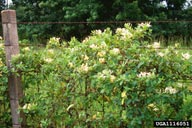 Plant(s); Charles T. Bryson, USDA Agricultural Research Service, Bugwood.org Additional Resolutions & Image Usage |
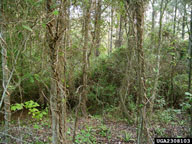 Infestation; vines Chuck Bargeron, University of Georgia, Bugwood.org Additional Resolutions & Image Usage |
 Infestation; Chuck Bargeron, University of Georgia, Bugwood.org Additional Resolutions & Image Usage |
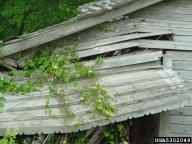 Infestation; Chuck Bargeron, University of Georgia, Bugwood.org Additional Resolutions & Image Usage |
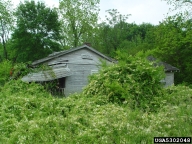 Infestation; Chuck Bargeron, University of Georgia, Bugwood.org Additional Resolutions & Image Usage |
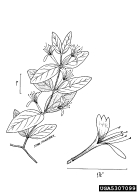 Diagram or Graphic; USDA NRCS. Wetland flora: Field office illustrated guide to plant species. USDA Natural Resources Conservation Service. USDA PLANTS Database, USDA NRCS PLANTS Database, Bugwood.org Additional Resolutions & Image Usage |
 Diagram or Graphic; Britton, N.L., and A. Brown. 1913. Illustrated flora of the northern states and Canada. Vol. 3: 280. USDA PLANTS Database, USDA NRCS PLANTS Database, Bugwood.org Additional Resolutions & Image Usage |
| EDDMapS Distribution: This map is incomplete and is based only on current site and county level reports made by experts and records obtained from USDA Plants Database. For more information, visit www.eddmaps.org |
 State(s) Where Reported invasive. Based on state level agency and organization lists of invasive plants from WeedUS database. |









